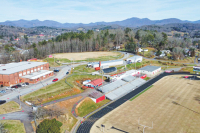Site near Cowee mound saved from development, turned over to tribe
 A mountainside in Macon County once destined for a housing development is now destined to be a community forest area comparable to the arboretum in Asheville.
A mountainside in Macon County once destined for a housing development is now destined to be a community forest area comparable to the arboretum in Asheville.
The Hall Mountain Tract is a 108-acre swath of land overlooking the Cowee mound — a sacred Cherokee site — and the Little Tennessee River. Local conservationists and Eastern Band of Cherokee Tribal members have been pushing hard since 2005 to save the site from becoming a large subdivision.
Last week, the eight-year conservation effort culminated with the Land Trust for the Little Tennessee signing over the deed to the Cherokee tribal government at a ceremony in Macon County. The site has cultural and historical significance to the tribe because of its location in an area that was once the center of civilization for the Cherokee and its proximity to the mound, which was where the tribe’s council house was located and was the site of other sacred ceremonies.
The tribe’s Principal Chief Michell Hicks spoke at the ceremony last week about the significance of the tract being returned to the tribe.
“When we put our people to rest it’s perpetual,” Hicks said. “We have to make things right and that’s why we’re here today.”
Related Items
The conservation of the Cowee mound site itself, 71 acres of waterfront property along the river, was one of the crowning achievements of the Land Trust for the Little Tennessee. The conservation group purchased the property with the help of state conservation funds and, in a process similar to what happened last week with the Hall Mountain tract, turned it over to the tribe in 2007.
However, that victory was tainted by the proposed development “Ironwood,” which would have forever changed the mound’s forested backdrop. Hall Mountain is the tallest peak in the county adjacent to the river. The organization tried to step in and work with the California-based developers, but to no avail.
“The owners had expectations way beyond what LTLT could compensate them for,” said the organization’s Executive Director, Paul Carlson. “They were planning a pretty ambitious development of the Hall Mountain tract. It would have filled up the viewshed.”
It wasn’t until the housing bubble burst and the property was foreclosed upon by Macon Bank that the land trust could make headway. It ended up buying the property and holding it until it could be handed over to the tribe — a step that came with the help of the federal government.
The U.S Forest Service provided the tribe with $300,000 in matching funds through its newly formed Community Forest and Open Space Conservation Program to help with the purchase.
The Hall Mountain project was one of only 10 community forest projects across the country to receive money from the program in its first round of awards last year. It beat out more than 40 other applicants.
The funding stipulates that the site must be used for the benefit of the community, said the program’ manager, Scott Stewart, who came from Washington, D.C., to the ceremony in Macon County
“The goal of the program is to create community forests for education, recreation and economic benefits to the community,” Stewart said.
At the site, the tribe is planning a network of walking and biking trails as well as interpretive signage, a pavilion, and perhaps a small camping area. The goal is to emphasize the natural and cultural significance of the area, said Tommy Cabe, forest resource specialist with the tribe.
The tribe is in the assessment phase of the project and no timeline has been set for the work. But when it is completed, Cabe hopes it provides protected forest and more open space for the community to make use of. As part of the stipulation for the grant funding, the land will be open to the general public.
“We would like to provide a place to bike, hike and be surrounded by nature,” Cabe said.
For tribal elder Jerry Wolfe, the return of his ancestor’s old stomping grounds to the tribe represented a milestone and ensured its protection for the future. He said it also represented an opportunity for the tribe’s youth to reconnect with their past and allows them the chance to see the Cowee mound similar to how it once was years ago.
“I think there is some progress in what is happening,” Wolfe said. “The mound is a very historical site — it’s there for the reason of permanent keeps.”









